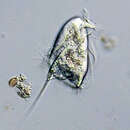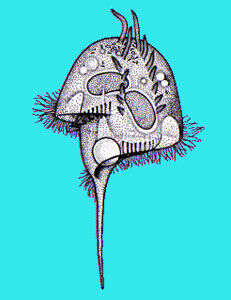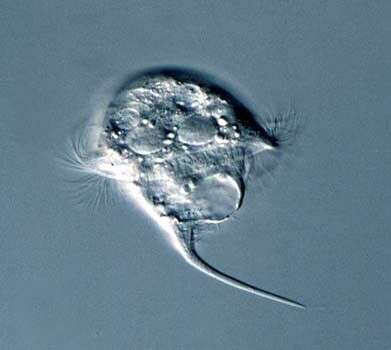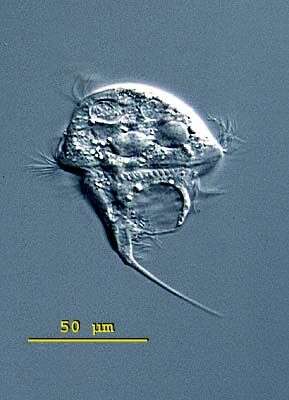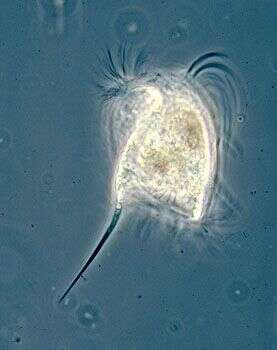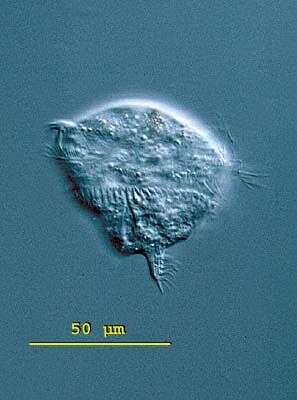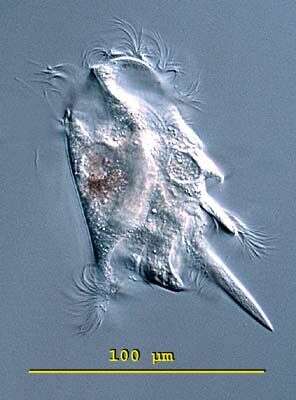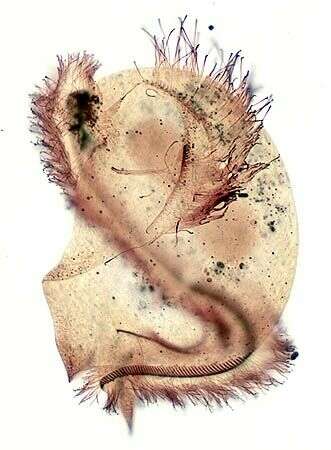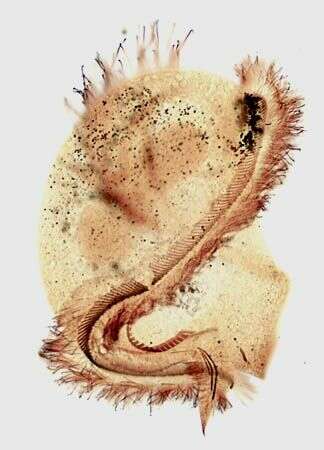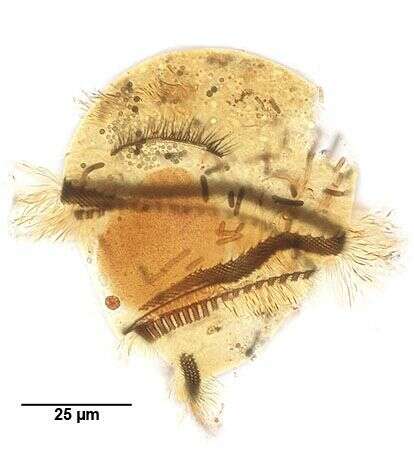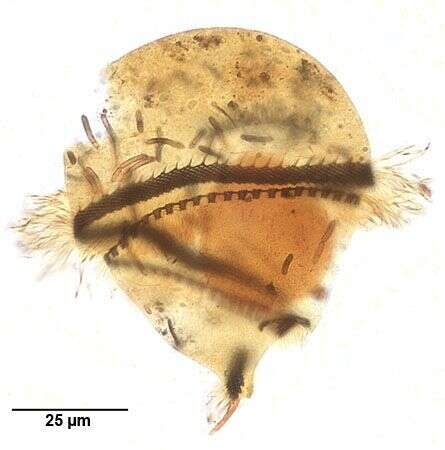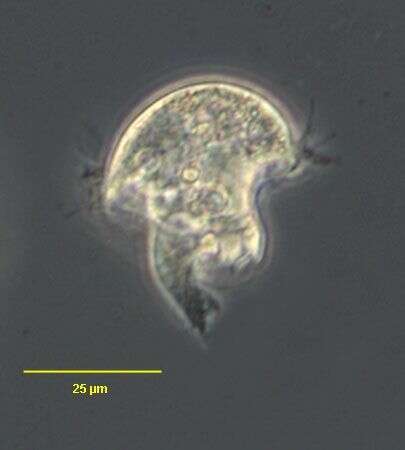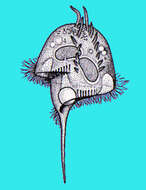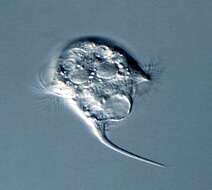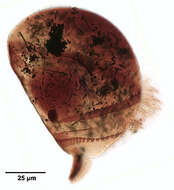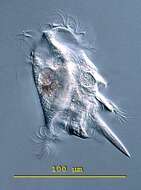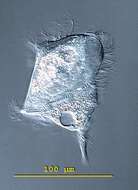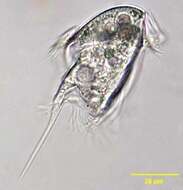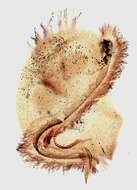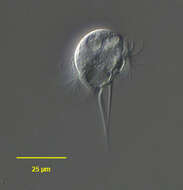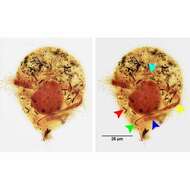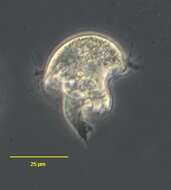-
-
Caenomorpha (seen-owe-morph-a) medusula. Body medusoid with 1 to 3 posterior spines. Without somatic cilia except for a band which lies near the membranelles. The membranelles form a long spiral that encircles the body and ends in posteriorly situated cytostome. A contractile vacuole is located at the base of the spine. Symbiotic (methanogenic) bacteria occur in the cytoplasm. Move very quickly, with a jerky rotation. Between 1-4 macronuclei but always with only 1 micronucleus. Common in anoxic habitats. This specimen was collected in a bog near Konstanz, Germany. Slightly squashed specimen of Caenomorpha medusula. Focal plane on the rim of the bell-shaped anterior half of the body. Specimen measures 90 microns. Differential interference contrast.
-
Caenomorpha (seen-owe-morph-a) medusula. Body medusoid with 1 to 3 posterior spines. Without somatic cilia except for a band which lies near the membranelles. The membranelles form a long spiral that encircles the body and ends in posteriorly situated cytostome. A contractile vacuole is located at the base of the spine. Symbiotic (methanogenic) bacteria occur in the cytoplasm. Move very quickly, with a jerky rotation. Between 1-4 macronuclei but always with only 1 micronucleus. Common in anoxic habitats. This specimen was collected in a bog near Konstanz, Germany. The two macronuclei are visible near the center of the body and the contractile vacuole is located at the base of the spine. 90 microns long. Differential interference contrast.
-
Portrait of the armophorid ciliate, Caenomorpha medusula (Perty,1852). The colorless pellicle is rigid and twisted to the left. The anterior is broadly rounded and umbrella-like with a long posterior spine. Somatic ciliature is reduced to 2 rows of thigmotactic cirri on the left side of the anterior dome. The peristome spirals around the long axis, bordered anteriorly by a perizonal stripe of cilia and posteriorly by an adoral zone of membranelles. The cytostome situated at the posterior end of the peristome. There are 3 or 4 spherical macronuclei; 1 posterior contractile vacuole is located at the base of the spine . The cytoplasm contains multiple endosymbiotic methanogenic bacteria. C. medusula is found in anaerobic habitats. C. medusula is distinguished fro other species in the genus by its shape and by its two anterior cirral files (other species have only one). Collected from sapropelic bottom sediments of a slow-flowing freshwater stream near Boise, Idaho January 2005. DIC.
-
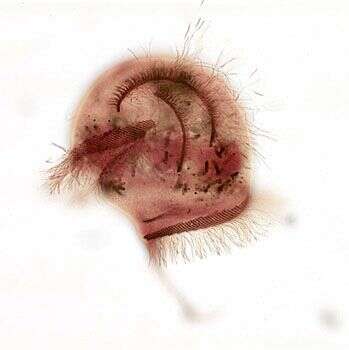
Portrait of the armophorid ciliate, Caenomorpha medusula (Perty,1852). The colorless pellicle is rigid and twisted to the left. The anterior is broadly rounded and umbrella-like with a long posterior spine. Somatic ciliature is reduced to 2 curved rows of thigmotactic cirri on the left side of the anterior dome (seen well here). The peristome spirals around the long axis, bordered anteriorly by a perizonal stripe of cilia and posteriorly by an adoral zone of membranelles. The cytostome situated at the posterior end of the peristome. There are 3 or 4 spherical macronuclei; 1 posterior contractile vacuole is located at the base of the spine . The cytoplasm contains multiple endosymbiotic methanogenic bacteria. C. medusula is found in anaerobic habitats. C. medusula is distinguished fro other species in the genus by its shape and by its two anterior cirral files (other species have only one). Collected from sapropelic bottom sediments of a slow-flowing freshwater stream near Boise, Idaho January 2005.Stained by the silver carbonate technic (see Foissner, W.Europ. J. Protistol.27,313-330;1991) Brightfield.
-
Phase contrast micrograph of living cell.
-
Caenomorpha (seen-owe-morph-a) uniserialis. Body medusoid with 1 to 3 posterior spines. Without somatic cilia except for a band which lies near the membranelles. The membranelles form a long spiral that encircles the body and ends in posteriorly situated cytostome. A contractile vacuole is located at the base of the spine. Symbiotic (methanogenic) bacteria occur in the cytoplasm. Move very quickly, with a jerky rotation. Between 1-4 macronuclei but always with only 1 micronucleus. Common in anoxic habitats. This slightly squashed specimen of Caenomorpha uniserialis was collected in a bog near Konstanz, Germany. The body of C. uniserialis is rather spherical. The short spine has a widened middle part. The cell is 72 microns long. Differental interference contrast.
-

Silver carbonate preparation (see Foissner, W.Europ. J. Protistol.27,313-330;1991) of the sapropelic armophorid ciliate, Caenomorpha uniserialis (Levander, 1894), right lateral view. The cell body is parachute-shaped with a smooth broad anterior shield. The anterior shield bears a single file of cirri-like cilia (not visible in this view). The body terminates posteriorly in two spinous processes, a short simple one (not seen in this image) and a complex terminal longer spine with folds, projections and several rows of cilia (seen well here). The perizonal ciliary stripe originates on the left lateral aspect anteriorly and makes a complete turn around the body along the spiraling peristome and terminates on the same longitudinal line posteriorly (seen here). The area of the cytostome is between the two spinous processes at the posterior end of the peristome. An adoral zone of membranelles posterior to the perizonal stripe of kineties parallels the spiral peristome (seen well here). An undulating membrane originates near the posterior end of the perizonal stripe between it and the adoral zone of membranelles and terminates at the cytostome (seen as a thin dark line in this image). The cytoplasm contains several forms of endosymbiotic bacilli (stained dark black in this image). The contractile vacuole (not seen here) is located at the base of the large spine. C. uniserialis is bactiverous. Collected from stagnant freshwater bottom sediment with rotting leaves and rich in hydrogen sulfide near Boise, Idaho August 2004. Brightfield optics.
-

Silver carbonate preparation (see Foissner, W.Europ. J. Protistol.27, 313-330; 1991) of the sapropelic armophorid ciliate, Caenomorpha uniserialis (Levander, 1894), left lateral view. The cell body is parachute-shaped with a smooth broad anterior shield. The anterior shield bears a single file of cirri-like cilia (seen well here). The body terminates posteriorly in two spinous processes, a short simple one (not seen in this image) and a complex terminal longer spine with folds, projections and several rows of cilia. The perizonal ciliary stripe originates on the left lateral aspect anteriorly and makes a complete turn around the body along the spiraling peristome and terminates on the same longitudinal line posteriorly (seen well here). The area of the cytostome is between the two spinous processes at the posterior end of the peristome. An adoral zone of membranelles parallels the spiral peristome (seen well here). An undulating membrane originates near the posterior end of the perizonal stripe and terminates at the cytostome (seen as a thin dark line in this image). The single large spherical macronucleus and the overlying micronucleus are seen well here. The cytoplasm contains several forms of endosymbiotic bacilli (stained dark black in this image). The contractile vacuole (not seen here) is located at the base of the large spine. C. uniserialis is bactiverous. Collected from stagnant freshwater bottom sediment with rotting leaves and rich in hydrogen sulfide near Boise, Idaho August 2004. Brightfield optics.
-

Portrait of the sapropelic armophorid ciliate, Caenomorpha uniserialis. The cell body is parachute-shaped with a smooth broad anterior shield. The anterior shield bears a single file of cirri (not seen here). The body terminates posteriorly in two spinous processes, a short simple one and a complex longer spine with folds and projections. The perizonal ciliary stripe winds along the spiraling peristome and terminates on the large posterior spine (seen well here). The area of the cytostome is seen between the two spinous processes at the posterior end of the peristome. An adoral zone of membranelles parallels the spiral peristome. The single large spherical macronucleus and the overlying micronucleus are seen well here. The yellowish refractile droplets in the cytoplasm may represent lipid. Many food vacuoles are present. The cytoplasm contains several forms of endosymbiotic bacteria. The contractile vacuole (not seen here) is located at the base of the large spine. C. uniserialis is bactiverous. Collected from stagnant freshwater bottom sediment with rotting leaves and rich in hydrogen sulfide near Boise, Idaho January 2004. DIC optics
-
Caenomorpha (seen-owe-morph-a) sapropelica. Body medusoid with 1 to 3 posterior spines. Without somatic cilia except for a band which lies near the membranelles. The membranelles form a long spiral that encircles the body and ends in posteriorly situated cytostome. A contractile vacuole is located at the base of the spine. Symbiotic (methanogenic) bacteria occur in the cytoplasm. Move very quickly, with a jerky rotation. Between 1-4 macronuclei but always with only 1 micronucleus. Common in anoxic habitats. This specimen was collected in a bog near Konstanz, Germany. 135 microns long. Differential interference contrast.
-
Caenomorpha (seen-owe-morph-a) sapropelica. Body medusoid with 1 to 3 posterior spines. Without somatic cilia except for a band which lies near the membranelles. The membranelles form a long spiral that encircles the body and ends in posteriorly situated cytostome. A contractile vacuole is located at the base of the spine. Symbiotic (methanogenic) bacteria occur in the cytoplasm. Move very quickly, with a jerky rotation. Between 1-4 macronuclei but always with only 1 micronucleus. Common in anoxic habitats. This slightly squashed specimen collected in a bog near Konstanz, Germany; measuring 135 microns. Differential interference contrast.
-
Portrait of polysaprobic heterotrich ciliate Caenomorpha sapropelica (Kahl, 1927). The rigid pellicle is colorless. The anterior is bluntly cone shaped and the posterior is drawn out as a long spine. Aggregate of dense brown granules anteriorly. Somatic ciliature is reduced to a single file of thigmotactic cirri on the left side of the anterior dome. The peristome spirals around the body terminating posteriorly at the cytostome.A perizonal stripe of cilia borders the peristome anteriorly. There is an adoral zone of membranelles on the posterior margin of the peristome. Posterior contractile vacuole. Multiple macronuclei are not seen in these images. From standing freshwater pond with decaying leaves near Boise, Idaho. Oblique illumination.
-
-
-
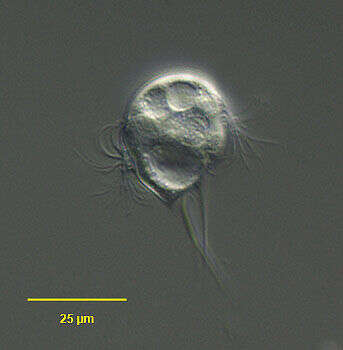
Portrait of the small caenomorphid ciliate, Ludio parvulus (Penard, 1922). The genus is monotypic. The colorless cell is roughly pyriform. The posterior end terminates in a short conical spinous projection. The pellicle is firm and only slightly deformable. The subequatorial peristome spirals around the body. The peristome is bordered anteriorly by a narrow perizonal ciliary stripe and also by an inconspicuous adoral zone of membranelles. The cytostome is at the posterior end of the peristome. A needle-like spine at least as long as the cell body arises on the right surface and extends posteriorly. A prominent cirrus approximately the same length as this spine trails behind the cell. A shorter anterior cirrus is not well seen in this image. The single spherical macronucleus is located eccentrically. The micronucleus is not clearly seen in these images. There is a single posterior contractile vacuole. L. parvulus is sapropelic. L. parvulus lacks the anterior rows of cirri seen in both Caenomorpha and Cirranter. Unlike Ludio, Cirranter lacks spines. Collected from a slow-moving freshwater stream near Boise, Idaho December 2004. DIC.
-
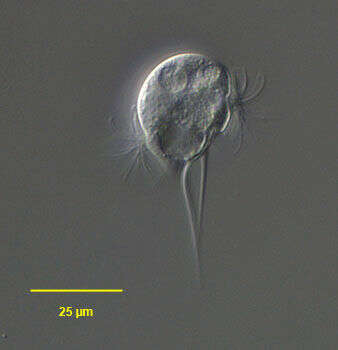
Portrait of the small caenomorphid ciliate, Ludio parvulus (Penard, 1922). The genus is monotypic. The colorless cell is roughly pyriform. The posterior end terminates in a short conical spinous projection. The pellicle is firm and only slightly deformable. The subequatorial peristome spirals around the body. The peristome is bordered anteriorly by a narrow perizonal ciliary stripe and also by an inconspicuous adoral zone of membranelles. The cytostome is at the posterior end of the peristome. A needle-like spine at least as long as the cell body arises on the right surface and extends posteriorly. A prominent cirrus approximately the same length as this spine trails behind the cell (seen here to viewr's left of long posterior spine). A shorter anterior cirrus is not well seen in this image. The single spherical macronucleus is located eccentrically. The micronucleus is not clearly seen in these images. There is a single posterior contractile vacuole. L. parvulus is sapropelic. L. parvulus lacks the anterior rows of cirri seen in both Caenomorpha and Cirranter. Unlike Ludio, Cirranter lacks spines. Collected from a slow-moving freshwater stream near Boise, Idaho December 2004. DIC.
-
Ventral Infraciliature of the armophorid ciliate Caenomorpha simplex (Jankowski,1964). Stained by the silver carbonate technique (see Foissner, W. Europ. J. Protistol., 27:313-330;1991).Brightfield.
-
Infraciliature of the armophorid ciliate Caenomorpha simplex (Jankowski,1964). The light blue arrowhead indicates the single anterior cirral file. The green, dark blue and yellow arrowheads indicate the undulating membrane, adoral zone of membranelles and perizonal ciliary stripe respectively. The red arrowhead indicates one of the densely stained methanogenic bacteria in the cytoplasm.Stained by the silver carbonate technique (see Foissner, W. Europ. J. Protistol., 27:313-330;1991).Brightfield.
-
Dorsal infraciliature of the armophorid ciliate Caenomorpha simplex (Jankowski,1964). Stained by the silver carbonate technique (see Foissner, W. Europ. J. Protistol., 27:313-330;1991).Brightfield.
-
Caenomorpha simplex (Jankowski,1964).Phase contrast.

